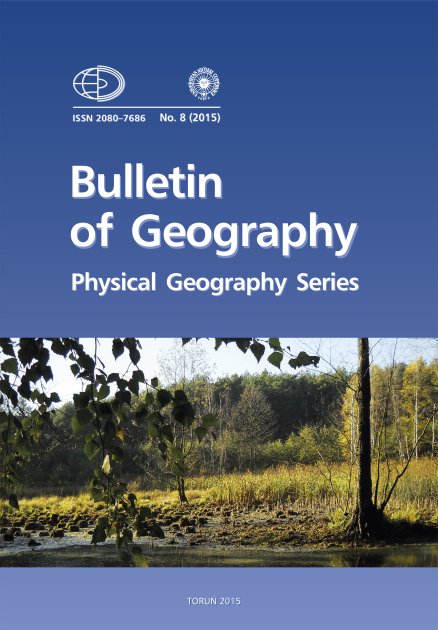Structure and importance of soil-protecting forests in the areas administered by the RDSF Toruń
DOI:
https://doi.org/10.2478/7036Keywords
soil-protecting forest, forest structure, soil protection, RDSF ToruńAbstract
The paper presents the state and importance of soil-protecting forests in the areas managed by the RDSF in Toruń, as well as changes in their structure over 29 years. The management of the RDSF in Toruń is characterized by a systematic increase in the area, thickness and rich abundance of soil-protecting forests, particularly intense since the mid-nineteen-nineties. They cover mainly rusty soils and podzols on outwash areas, sandy terraces in sloped areas of postglacial valleys and gullies as well. Soil-protecting forests, which are managed by the RDSF in Toruń, vary a great deal considering their habitat, both in terms of dampness and trophic richness as well as spatially. The dominance of coniferous forests is due to the fact that they grow in the poorest habitats, which have not been previously used for agricultural purposes, and to the common practice in recent years of pine reforestation in open stromal areas. The assessment of the state of habitats indicates that 66.2% of the soil-protecting forest area is characterized as natural and close-to-natural. Distorted or transformed habitats occupy 26.2% of the soil-protecting forest area, while the degraded habitats 7.6%. Taking the study area into consideration we can observe the relationship between the incompatibility of habitat in its natural form and the post-arable feature. Changes in habitat characteristics are shown by 75.5% of the area of the soil-protecting forest located on former farmland, mainly in the areas with rusty podzolic soils (Albic Brunic Arenosols). Incompatibility of the habitats is, among others, the result of the creation in recent years, during the afforestation of agricultural lands, of solid pine stands, also in fertile habitats. Secondary planted pine monocultures in the forest areas resulted in podzolization of rusty soils and transformed them into rusty podzolic soils.References
BEDNAREK R., DĄBROWSKI M., ŚWITONIAK M., 2009, Antropogeniczne przekształcenia pokrywy glebowej w wybranych typach rzeźby młodoglacjalnej na przykładzie gminy Jeżewo. Zeszyty Problemowe Postępów Nauk Rolniczych, 540: 139–146.
BIAŁY K., BROŻEK S., CHOJNICKI J., CZĘPIŃSKA-KAMIŃSKA D., JANUSZEK K., KOWALKOWSKI A., KRZYŻANOWSKI A., OKOŁOWICZ M., SIENKIEWICZ A., SKIBA S., WÓJCIK J., ZIELONY R., 2000, Klasyfikacja gleb leśnych Polski. Centrum Informacyjne Lasów Państwowych, Warszawa.
DYREKCJA GENERALNA LASÓW PAŃSTWOWYCH, 2004, Siedliskowe podstawy hodowli lasu, Załącznik nr 1 do Zasad hodowli i użytkowania lasu wielofunkcyjnego. Centrum Informacyjne Lasów Państwowych, Warszawa.
GESZPRYCH M., 2009, Specyfika nadzoru i sfera wartości w prawie leśnym. Studia Lubuskie, V: 159–181.
JAKUBOWSKI G., 1994, Lesistość a problemy ochrony środowiska. Postępy Techniki w Leśnictwie, 55: 65–71.
KLOCEK A., 1999, Pozaprodukcyjne funkcje lasu jako publiczne świadczenia gospodarki leśnej oraz stany jej równowagi. Sylwan, 143: 5–20.
KLOCEK A., 2003, Ekonomiczne aspekty leśnictwa w krajach Unii Europejskiej i w Polsce. Sylwan, 147: 1–11.
MINISTERSTWO LEŚNICTWA I PRZEMYSŁU DRZEWNEGO, 1957, Instrukcja urządzania lasu. Państwowe Wydawnictwo Rolnicze i Leśne, Warszawa.
MINISTERSTWO OCHRONY ŚRODOWISKA, ZASOBÓW NATURALNYCH I LEŚNICTWA, 1997, Polityka leśna państwa. Wydawnictwo Świat, Warszawa.
MIŚ R., 2007, Urządzanie lasów wielofunkcyjnych. Wydawnictwo Akademii Rolniczej im. Augusta Cieszkowskiego, Poznań.
NOWAKOWSKA J., 2008, Niektóre obszary leśne o specjalnym przeznaczeniu (funkcjach) w ujęciu historycznym. Studia i Materiały Centrum Edukacji Przyrodniczo-Leśnej, 3: 34–40.
PAŃSTWOWE GOSPODARSTWO LEŚNE LASY PAŃSTWOWE, 2003, Instrukcja urządzania lasu, część 2, Załącznik do Zarządzenia nr 43 Dyrektora Generalnego Lasów Państwowych z dnia 18 kwietnia 2003 r. Centrum Informacyjne Lasów Państwowych, Warszawa.
PAŃSTWOWE GOSPODARSTWO LEŚNE LASY PAŃSTWOWE, 2012, Zasady hodowli lasu. Centrum Informacyjne Lasów Państwowych, Warszawa.
PAŃSTWOWE GOSPODARSTWO LEŚNE LASY PAŃSTWOWE, 2014, Wyniki aktualizacji stanu powierzchni leśnej i zasobów drzewnych w Lasach Państwowych na dzień 1 stycznia 2013 roku. Oficyna Wydawnicza Forest, Józefów.
PUCHNIARSKI T.H., 2000, Krajowy program zwiększania lesistości. Zalesienia porolne. Poradnik od A do Z. Państwowe Wydawnictwo Rolnicze i Leśne, Warszawa.
ŚWITONIAK M., JANKOWSKI M., BEDNAREK R., 2014, Antropogeniczne przekształcenia pokrywy glebowej Brodnickiego Parku Krajobrazowego. Wydawnictwo Naukowe UMK, Toruń.
THE ACT OF 28 SEPTEMBER 1991 ON FORESTS, Journal of Laws 2011, Item 59 as amended.
WIŚNIEWSKI P., 2012, Przeciwerozyjna funkcja lasów glebochronnych na przykładzie obszarów zarządzanych przez RDLP w Toruniu. PhD thesis, Uniwersytet Technologiczno-Przyrodniczy, Bydgoszcz.
WIŚNIEWSKI P., WOJTASIK M., 2012, Glebochronna funkcja lasów a zalesienia porolne na przykładzie Nadleśnictwa Szubin. Polish Journal of Agronomy, 11: 81–88.
WIŚNIEWSKI P., WOJTASIK M., 2014, Zróżnicowanie właściwości gleb uprawnych oraz leśnych na erodowanych stokach. Inżynieria Ekologiczna, 39: 198–208.
WYSOCKI CZ., SIKORSKI P., 2009, Fitosocjologia stosowana w ochronie i kształtowaniu krajobrazu. Wydawnictwo SGGW, Warszawa.
ZAJĄCZKOWSKI J., 2003, Rola zasad hodowli lasu w kształtowaniu trwałej wielofunkcyjności polskich lasów i leśnictwa. Sylwan, 147: 3–9.
Downloads
Published
How to Cite
Issue
Section
Stats
Number of views and downloads: 549
Number of citations: 0



